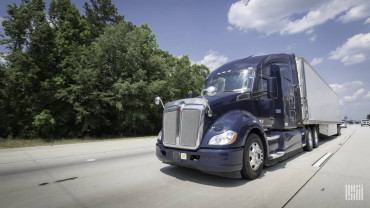Capacity needs of long-haul trucking and last mile are diverging faster than ever

The U.S. trucking industry is massive, sustaining millions of stakeholders in a market that is worth close to a trillion dollars annually. Its sheer scale brings in volatility to capacity and volumes available to haul, determined by macroeconomic factors that dictate supply-and-demand equations across the spectrum.
FreightWaves caught up with Tech Mahindra executives Lakshmanan Chidambaram, the president of Americas strategic verticals, and Pravat Rath, the vice president of the company’s retail business group, to discuss the factors leading to the excess capacity predicament in long-haul trucking and the increasing need for capacity in last-mile delivery.
“The surge in capacity we saw over the last few years has resulted in excess capacity that is not getting utilized today, hurting the trucking companies. They are cutting down costs in every possible way, with several companies even going bankrupt,” said Chidambaram.
On a global scale, the drawn-out U.S.-China trade war and the more recent coronavirus debacle will continue to have a definitive impact in reducing the volumes being hauled. Being the world’s largest exporter and second-largest importer, China is a behemoth in global trade and the shutdown of its logistics machinery will send ripples all across North America.
“The sentiments are not very positive. There’s a strong indicator that supply chains could alter. Instead of acquiring from China, it could shift to elsewhere on the globe. It could come back to the U.S. or go to Southeast Asia, but this uncertainty is not healthy,” said Chidambaram.
That said, the rise of e-commerce is synthesizing demand for last-mile delivery capacity. Consumers getting accustomed to having products delivered at their doorstep are posing problems to retail chains like Walmart and Costco, though they have a ubiquitous storefront presence across the country.
With their backs to the wall, these retail giants are now looking to make the in-store buying experience more exciting for their customers. This apart, they are also starting localized direct-to-consumer (DTC) deliveries, which could potentially reach their customers faster than Amazon — courtesy of their physical store proximity to a significant portion of the population.
“With the advent of new technologies like 5G, there will be new kinds of offerings that the DTC companies will come up with so that we can have not only faster deliverables but a much richer experience in ordering online and getting them fulfilled,” said Rath. “Traditionally there have been these long lanes like L.A. to New York or L.A. to Chicago that had seen an increase in capacity but are now not getting utilized as much as it should be. But as these capacities are coming down, the e-commerce capacities are growing phenomenally.”
Data analytics of consumer buying patterns are driving a futuristic race that is dubbed “yesterday’s delivery” — a concept of setting logistics in motion on products that have not been ordered but will be ordered in the near future.
E-commerce companies that cater to consumers with a long buying history on their platforms can anticipate their needs well in advance and keep the products ready in warehouses close to their locations, ready to be shipped at a moment’s notice. This would help shorten delivery cycles to a few hours from the moment an order gets placed — an improvement from the same-day delivery models that are growing in relevance today.
“Ultimately, all this goes towards improving customer experience and towards understanding your customer behavior better. Over a period of time, these companies will start knowing us better, as much as we do or sometimes even better than we do ourselves,” said Chidambaram. “They will know our past and current buying behavior and use that to predict what we will buy in the future. This will help them to plan production, give us the right incentives to order the product and move it to our doorstep faster than ever.”
